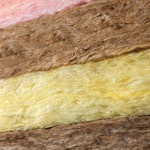 Man-made vitreous fibers (MMVFs) or synthetic vitreous fibers (SVFs), specifically glass, rock/stone or slag wools, have multiple end-use applications but are most commonly used as insulation. MMVFs have been studied by health and safety experts for decades. Most notably, the potential carcinogenicity (ability or tendency to produce cancer) of these fibers has been evaluated by toxicology studies in the form of large epidemiological cohort studies of MMVF manufacturing workers, in inhalation studies in experimental animals (in vivo), and in laboratory fiber solubility studies (in vitro).
Man-made vitreous fibers (MMVFs) or synthetic vitreous fibers (SVFs), specifically glass, rock/stone or slag wools, have multiple end-use applications but are most commonly used as insulation. MMVFs have been studied by health and safety experts for decades. Most notably, the potential carcinogenicity (ability or tendency to produce cancer) of these fibers has been evaluated by toxicology studies in the form of large epidemiological cohort studies of MMVF manufacturing workers, in inhalation studies in experimental animals (in vivo), and in laboratory fiber solubility studies (in vitro).
Based on the results of these studies, in 2002, the International Agency for Research on Cancer (IARC) downgraded their classification of insulation glass wool, rock/stone wool, and slag wool from “possibly carcinogenic in humans” (Group 2B) to “not classifiable as to its carcinogenicity in humans” (Group 3).1,2 Following this classification, MMVF manufacturers around the world removed cancer warning labels from their products, except for fiber glass manufacturers in the United States.
Nearly a decade following IARC’s decision to downgrade MMVFs classification to Group 3 substances, the U.S. National Toxicology Program (NTP) stated that “not all glass wool fibers cause cancer” and removed from their Report on Carcinogens biosoluble glass wool fibers used in home and building insulation.3 Similarly, California’s Office of Environmental Health Hazard Assessment (OEHHA) published a modification to its Proposition 65 listing to remove the biosoluble glass fibers used in building insulation from the Proposition 65 list, leaving only “inhalable and biopersistent” non-insulation special purpose glass wool fibers requiring a Proposition 65 warning.4 The actions taken by IARC, NTP, and OEHHA removed all federal and state legal requirements for cancer warning labels on packages of biosoluble fiber glass used in today’s fiber glass insulation.
The conclusions of IARC, NTP, and OEHHA were informed by one of the largest and most comprehensively studied occupational epidemiological cohorts to date. That study analyzed U.S. MMVF manufacturing workers and included over one million person-years of observation.5 These decisions were also aligned with conclusions from Health Canada, the Agency for Toxic Substances and Disease Registry (ATSDR), and the National Academy of Sciences throughout the early 2000s, which found no significant association between fiber exposure and lung cancer or nonmalignant respiratory disease in MMVF manufacturing workers. 6,7,8
Despite this consensus from regulatory agencies and scientific bodies, NAIMA continues to sponsor health and safety evaluations of MMVFs. Most recently, in 2020 NAIMA sponsored a systematic literature search and review of MMVF carcinogenicity evidence published since the release of the 2002 IARC Monograph. The evaluation of the in vivo evidence primarily showed no carcinogenic potential or pathogenic effects upon exposure to MMVF fibers, and no relevant in vitro studies published since the 2002 Monograph were identified. Similarly, an updated evaluation of the epidemiological evidence found no evidence to suggest that MMVF exposure is associated with respiratory tract cancer.9 Collectively, the independent scientists who conducted this updated review of evidence concluded that the 2001 IARC decision to downgrade insulation glass wool, rock/stone wool, and slag wool to Group 3 substances remains valid in terms of new scientific evidence.
- Baan RA and Grosse Y, 2004. Man-made mineral (vitreous) fibres: evaluations of cancer hazards by the IARC Monographs Programme. Mutation Research/Fundamental and Molecular Mechanisms of Mutagenesis 553, 43-58.
- IARC (2002). Monographs on the Evaluation of Carcinogenic Risk to Humans. Vol. 81, Man-Made Vitreous Fibres. Lyons, France.
- S. Department of Health and Human Services, National Institute for Environmental Health Sciences, National Toxicology Program, Report on Carcinogens, Fourteenth Edition, Substance Profile: Certain Glass Wool Fibers (Inhalable) (https://ntp.niehs.nih.gov/ntp/roc/content/profiles/glasswoolfibers.pdf).
- Biosoluble glass wool fibers dissolve more rapidly in body fluids than other fibers that have been associated with human disease.
- Marsh, G. M., A. O. Youk, et al. (2001). "Historical cohort study of US man-made vitreous fiber production workers: I. 1992 fiberglass cohort follow-up: initial findings." Journal of occupational and environmental medicine 43(9): 741-756.
- Canada, Government of, Priority Substances List Assessment Report – Mineral Fibres (Man-Made Vitreous Fibres) (1993).
- Toxicological Profile for Synthetic Vitreous Fibers (U.S. Department of Health and Human Services, Public Health Services, Agency for Toxic Substances and Disease Registry), September 2004, pp. 1-11, 13.
- NRC Subcommittee on Manufactured Vitreous Fibers. 2000. Review of the U.S. Navy’s Exposure Standard for Manufactured Vitreous Fibers. National Academy of Sciences, National Research Council, Washington, D.C.: National Academy Press.
- Egnot, N. S., S. M. Benson, et al. (2020). "Systematic review and meta-analysis of epidemiological literature evaluating the association between exposure to man-made vitreous fibers and respiratory tract cancers." Regulatory Toxicology and Pharmacology 112: 104585.





